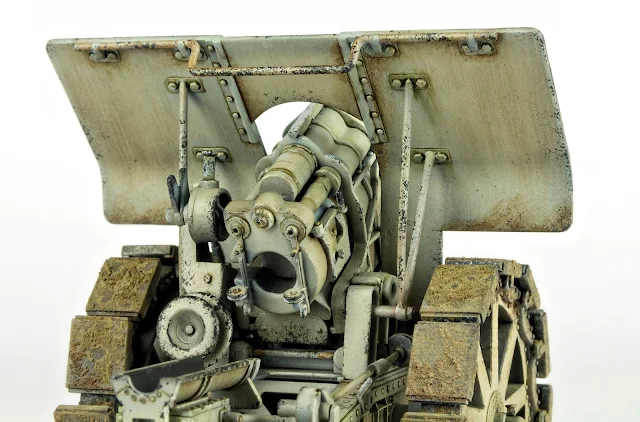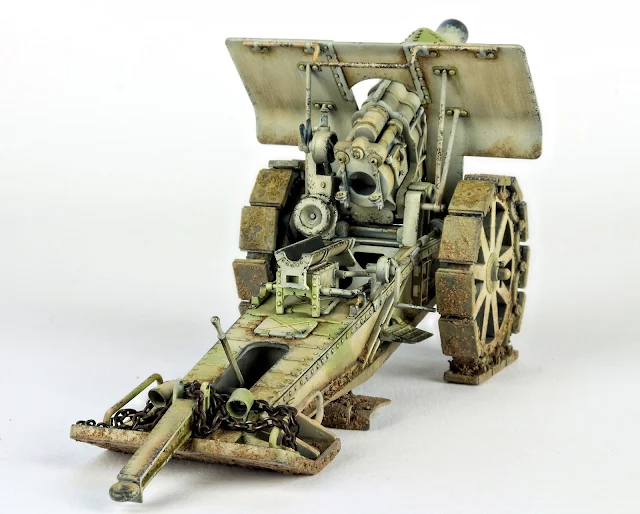Last week Andy Moore looked at the new Krupp 21cm Mörser 10/16 from Takom, he liked what see saw enough to
do a second part of the article – this time with paint from AMMO to compliment
the schemes provided in the box – Let’s see just how he got this gun looking so very good in today’s article…
Build review Pt.II – Painting
& Weathering the Krupp 21cm Mörser
10/16
From Takom
Kit no. 2032
1/35th scale
Price: ¥4,230/ USD $34.14/ €31.07 @HLJ.com
In part 1 we looked at the construction of Takom's new
howitzer. Now we'll get onto the best part of a build (for me, at least); the
painting and weathering.
For this build, I decided to model the early 1910 version
with the shorter barrel. Specifically, the marking option for the gun captured
by Canadian troops at Vimy Ridge in 1917. The main appeal of this subject for
me was the interesting sand/green camo and the graffiti applied by the soldiers
to mark their prize. The only down side to this choice was the fact that the
profiles show all the early 1910 versions as lacking the track pads on the
wheels. By luck, I found a couple of shots of the gun in question online which
showed that it did, in fact, have the pads fitted. So that solved all the
problems. I could paint the most interesting scheme and also use those
fantastic track pads.
The first step after washing all the parts in soapy water,
was to apply a primer. For this stage, I tried a grey primer from the AMMO range. I hadn't used these primers before so didn't know what to expect with
them. Other acrylic primers I've used in the past have been a bit hit and miss
but I found the AMMO primer to spray really well leaving a smooth satin finish
that didn't obscure any fine detail. Having said that, it's important to apply
it correctly, building up thin coats and allow it to fully cure for about 24
hours.
The paint guide for this scheme shows an area of worn paint
around the end of the barrel which is marked as being Mig-008 Dunkelgrau. The
period photos confirm this, but it's anyone's guess as to whether it's actually
Dunkelgrau, a primer, deposits from the gun being fired or raw, exposed metal.
I decided to spray the barrel in a suitable dark grey and, while I'd got the
airbrush loaded, I gave the rest of the model a loose pre-shade.
The track pads were also base coated in this colour, and
were attached to a strip of cardboard with masking tape to make spraying
easier.
To simulate the worn areas on the barrel, I sponged on some
masking fluid. This is a simple way of achieving chipped paint on a small area
and avoids the hassle of using hairspray.
The base coat was applied with the recommended Mig-057
Yellow Grey. Like the primer, using AMMO paints was a first for me and I found
them to spray well with good coverage, although, despite being airbrush ready,
I got better results thinning the paints to about a 50/50 ratio.
The paint was built up gradually in thin layers, allowing
each layer to dry for a few moments and leaving some of the pre-shade showing
through.
Once the base coat was dry (I left it overnight to be
certain) I rubbed away the masking fluid on the barrel to reveal the dark grey
beneath.
With the base coat on and dry, it was time for the camo. The
colour recommended in the paint profile is Mig-916 Green Base which is part of
their German camo modulation range which, to me, appears to be a little too
dark in comparison with the profile illustration which shows a paler sage
green. As I didn't have this colour in stock anyway, I decided to mix an
alternative that matched the illustration more closely. I picked Mig-060 Pale
Green from their French WWI box set. On its own, this was a little too green so
I mixed in some of the base Yellow Grey in a roughly 60/40 ratio, green to
yellow. This gave a pretty good match to the colour in the illustration.
Once the green was dry, I added a few paint chips with the
base yellow over the green areas, mainly around the edges of the gun shield.
These were applied with a sponge and a fine brush.
At this point, I had to decide whether I'd add the decals
now or wait until the bulk of the weathering was complete.
In reality, the markings were applied by the Canadian troops
who captured the gun and would have been painted on top of a weathered surface. As a modeller, however, I like to get the decals down and
sealed at a fairly early stage, before any aggressive weathering happens.
In the end, I decided to go the conservative route and add
them before the main weathering, although I did first add some extra paint chipping
with dark grey around areas that would naturally get worn.
The decals went down well, but they are very thin and needed
some coaxing to lay flat with no wrinkles. They're also very matt which worried
me a little as I was applying them, but once they were sealed with a satin
coat, the carrier film disappeared. The only fly in the ointment was with the
red text on the side of the barrel. Although well printed, it's far too large
when compared to the period photo and I ended up having to cut off the “WPG “and
apply it separately otherwise it would have extended too far down, over the
bottom edge of the barrel
With the decals on and sealed. It was time to start on the
weathering. The first step was to apply a couple of colour washes to tone down
the contrast in the camo. The first one was a brown acrylic wash from Vallejo.
This was simply painted over the whole surface, some areas getting a second
coat to add some variety to the finish. On some parts, I streaked the wash as
it was drying, using a wide, flat brush. This was mainly done on the vertical
surfaces such as the gun shield and the sides of the box trail. When using an
acrylic wash as a filter, it's important to get a thin even coat over the area
you're working on and not let the wash pool. Also, avoid adding any water to
the surface as the wash is drying or you'll end up with tide marks in the
finish.
An enamel filter, Mig-1507 Tan for Yellow Green, was used
for the second colour wash. Again, this toned down the finish and added an aged
weathered appearance to the model.
After the filters came the pin wash. This really helped
bring all the detail of the bolts and rivets out. Mig-1608 Dark Green Grey was
used for this and, although technically intended as an aircraft panel line
wash, is perfectly suited to subjects like this one.
Earth coloured oil paint was used to add more dirt build-up
around the edges of panels and, particularly, around the spade tails. The paint
was brushed on then blended with a soft brush, dampened with thinners.
With the bulk of the weathering done, I could start the
final assembly. The gun and mount simply attach to the top of the box trail
and, due to a poly-cap inserted in the pivot, the gun remained fully poseable.
Once the gun was on, the rest of the small details were
attached, leaving just the wheels off for the final round of weathering. A bit
of care was needed at this point as, with all the small parts added, the model
became very fragile.
Now the gun shield was in place, I could add the two struts
that had broken during assembly. This was a simple job, just cutting two
lengths of styrene rod to the correct angle at each end, then attaching with
super glue.
With the main structure together, I started to weather the
wheels, having already added the track pads. The first step was to sponge on
some earth coloured acrylic paint around the pads and on the spokes.
I then made up a mud mix using garden soil and earth
pigments and applied this quite liberally around the wheel rims and track pads.
This was fixed in place with a pigment fixer.
The same mix was added around the lower edges of the box
trail and anywhere else that dirt would accumulate. I worked on small areas at
a time, adding the pigment and fixing it in place before moving on to another
area.
Once the pigment fixer had dried, the final thing to do was
thin some earth coloured acrylic and lightly spray it over and around the muddy
areas to help blend the pigments in to the rest of the weathering. With that
last step done, the weathering was complete. As a final, final step, I added a
length of blackened chain to the spade tail to add a touch of individuality.
There's been a couple of firsts for me in this build; this
is the first artillery piece I've build and, as it now looks a little lonely
sitting in a display cabinet, surrounded by big tanks, I don't think it will be
the last. I can see myself picking up some of Takom's other artillery releases
to balance thing out a bit 

It's also been the first time I've used the AMMO range of
primers and paints and I've been quite impressed so far. They sprayed well once
thinned and left a nice smooth surface and seem to stand up well to handling.
I'll definitely be experimenting more with these paints in the future.
Here it is in detail...
And a whole "walkaround" for the final result...
Takom have produced a great little model here. It's full of
charm and personality (if a huge gun can have charm). The parts are well
detailed and accurate and the build was strait forward (with the exception of a
couple of broken parts, which were an easy fix), but the real fun came with the
painting and weathering and Takom certainly gives you plenty of choice on that
front with the seven colour schemes included. If you're into First World War
subjects, big guns or just great models, this comes highly recommended.
Andy Moore
Thanks to Takom for sending this kit for
us to build and review
Part I – Box contents & Construction shows this kit being constructed by Andy...














































